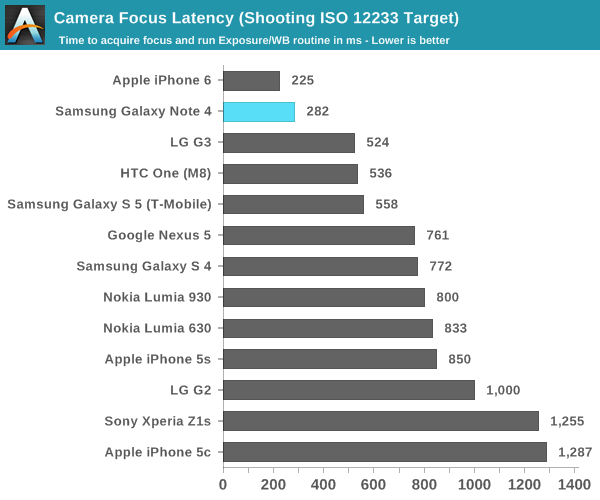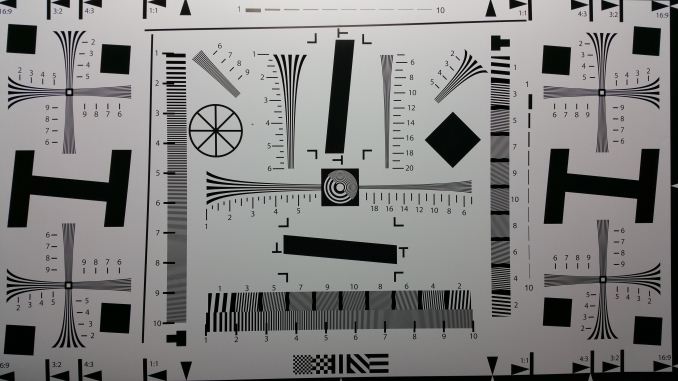The Samsung Galaxy Note 4 Review
by Joshua Ho on October 15, 2014 9:00 AM EST- Posted in
- Smartphones
- Samsung
- Android
- Mobile
- Galaxy Note 4
Camera
While the 16MP camera of the Galaxy Note 4 is mostly what we would expect, Samsung has really changed things up with the addition of OIS. Outside of this addition and the Sony IMX240 sensor, there’s really not a lot of change when it comes to the Galaxy Note 4. This means that we see the same 31mm equivalent focal length and F/2.27 aperture. At this point, it seems that OIS has finally reached mainstream adoption as both Samsung and Apple are shipping OIS solutions on their phones. The front facing camera is noticeably different though, with a Samsung S5K6D1YX sensor that I haven't seen elsewhere.
However, before we get into the proper image quality analysis I wanted to first cover shot to shot latency and focus/AE latency, as both are critical to a good image capture experience. Even if it’s possible to get amazing photos from a camera, it doesn’t really matter if the moment is missed. In order to test this, we look at the ideal case, which is when the phone is pointed at the ISO chart with bright lighting to maximize contrast.


As one can see in the graphs above, capture latency and focus latency are quite competitive with on the Note 4. However, there is one crucial detail that the focus latency graph misses, which is that Samsung doesn’t have continuous auto-focus in preview with the Note 4. As a result, there’s realistically an additional latency period before the auto-focus begins to run. The result is that the total time from out of focus to in focus is realistically closer to 800ms, but if one immediately taps the display to begin an AF run it’s possible to achieve the lower bound value, which is just south of 300ms.
Still Image Performance
While I'm still working on moving towards a better test for cameras, for now we have our standard photo comparisons that should give a good idea of what to expect from a smartphone camera in comparison to other cameras. Our first test is the standard ISO chart, which allows for a good test of maximum resolution.

For this first test, it seems that Samsung hasn't really changed much when it comes to maximum resolution, and in general the Note 4 produces similar output to the Galaxy S5. To verify this and a test of dynamic range, we'll look at a landscape shot next.
In this test, we see that the Galaxy Note 4 generally does well with detail and dynamic range as the landscape is generally well-detailed, although there's quite a bit of detail that seems to be smudged away on the grass as it seems to be a flat green texture for the most part. There's also noticeable color artifacting on the bleachers in the distance. We'll look at the same scene in low light to get a better idea for what the Note 4 really brings to the table.
Here, in low light we see significant improvements in image quality when comparing the Galaxy S5 to the Galaxy Note 4. The iPhone 6 Plus and Note 4 are quite close in overal quality, but looking at the brick building on the right of the image shows that the iPhone 6 Plus is maintaining a higher level of detail in this scene.
In the case of HDR, Samsung continues to do a great job with their implementation. For the most part this feature is successfully implemented with no real halos or other artifacts even when there are moving objects in the shot. This is likely to be implemented through on-sensor HDR rather than image combination.





































195 Comments
View All Comments
KPOM - Wednesday, October 15, 2014 - link
To be fair, the iPhone 6 also charges faster if you use the iPad charger. AT's tests were using whatever charger they put into the box.MattL - Thursday, October 16, 2014 - link
... and the Note 4 comes with a higher volt charger, that's one of the advertised benefits.Mumrik - Wednesday, October 15, 2014 - link
Why all the comparisons to iPhones?I suspect that decision is made long before people arrive at a review like this. Competing Android handsets are what is relevant here.
KPOM - Thursday, October 16, 2014 - link
Not necessarily.tralalalalalala40 - Saturday, October 18, 2014 - link
they plot the data they haveJcm800 - Wednesday, October 15, 2014 - link
Err what happened to the comments about the external speaker audio /quality? Did I miss that or something? Great review apart from that.Native7i - Wednesday, October 15, 2014 - link
I was here to read some real deep review.wantthefun - Thursday, October 16, 2014 - link
Do you think the battery benchmark is biased to LCDs, since the AMOLEDs may perform much better on videos. I think the battery tables would switch around if the tests changed...MattL - Thursday, October 16, 2014 - link
Agreed... why aren't there more mixed content battery drain tests? Most sites will at least run web browsing + video drain... and some of the more interesting ones will try to run a combined test to show mixed use (probably more like normal use).tralalalalalala40 - Saturday, October 18, 2014 - link
when the scientific results don't agree with your bias find a test where it will.